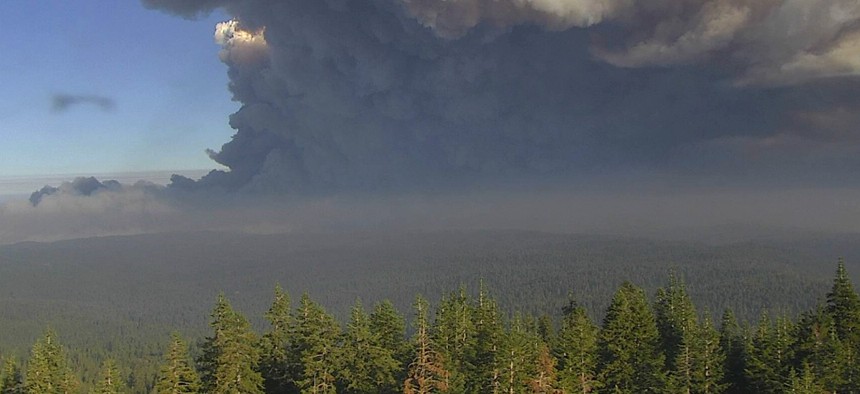California Lawmakers Call for NOAA-Led Research Testbeds to Study and Stop Wildfires

In this image from a U.S. Forest Service wildfire monitoring camera, plumes of smoke rise from the Caldor Fire in El Dorado County, Calif., on Tuesday, Aug. 17, 2021. U.S. Forest Service/ALERTWildfire Network via AP
The legislation would commit $15 million to such a pursuit in fiscal 2022.
House lawmakers want the National Oceanic and Atmospheric Administration to form one or multiple weather research testbeds where public, private and academic players can pursue more advanced capabilities for predicting, detecting and reacting to wildfires and their impacts.
The Fire Information and Reaction Enhancement, or FIRE, Act proposes authorizing $15 million to be appropriated for the next fiscal year to underpin such work. It was introduced by Rep. Mike Garcia, R-Calif., and co-sponsored by Reps. Julia Brownley, D-Calif., Judy Chu, D-Calif., and Young Kim, R-Calif, last week.
“In California, we know all too well the damage and devastation wildfires cause,” Garcia told Nextgov on Wednesday. “One of my top priorities in Congress is working to better prepare for and prevent wildfires.”
The West Coast state is one of multiple areas in America forced to confront unprecedented damage from wildfires in recent years. Risks of these emergencies depend on factors like temperature, soil moisture and tree presence—all of which are tied to climate change.
Data from the National Fire Information Center suggests more than 2 million acres of American land are being burned across more than 100 active large fires. The U.S. has endured more than 40,000 wildfires to date this year. That’s up from the number in 2020 by this time.
“As a member of the Science, Space, and Technology Committee, I became aware of the opportunity to utilize NOAA’s weather forecasting technology to help us predict wildfires, just like we do for tornadoes and hurricanes,” Garcia explained. He expressed hope that this legislation could grant the agency more flexibility and funds to pursue technology-based solutions to the ongoing threats. Introducing the bipartisan bill “has been a top priority of mine since coming to Congress,” the lawmaker added.
NOAA would work with academic and weather industry insiders to lead the testbed program proposed in the legislation. A primary aim of the effort would be to “develop and extend accurate wildfire forecasts and warnings in order to reduce loss of life, injury, property, and damage to the economy,” according to the bill. Focus would be placed on improving the forecasting of impending wildfires and their smoke dispersion, information dissemination and risk communication capabilities, and early detection aims among other topics.
The agency would be tasked with testing and deploying atmosphere and fire modeling systems, grid-based assessments of danger levels, satellite detection services and more.
Garcia’s bill was referred to the House Committee on Science, Space, and Technology.
“As we face increasingly catastrophic wildfire seasons, we must prioritize doing what we can to mitigate the devastation,” he said.






